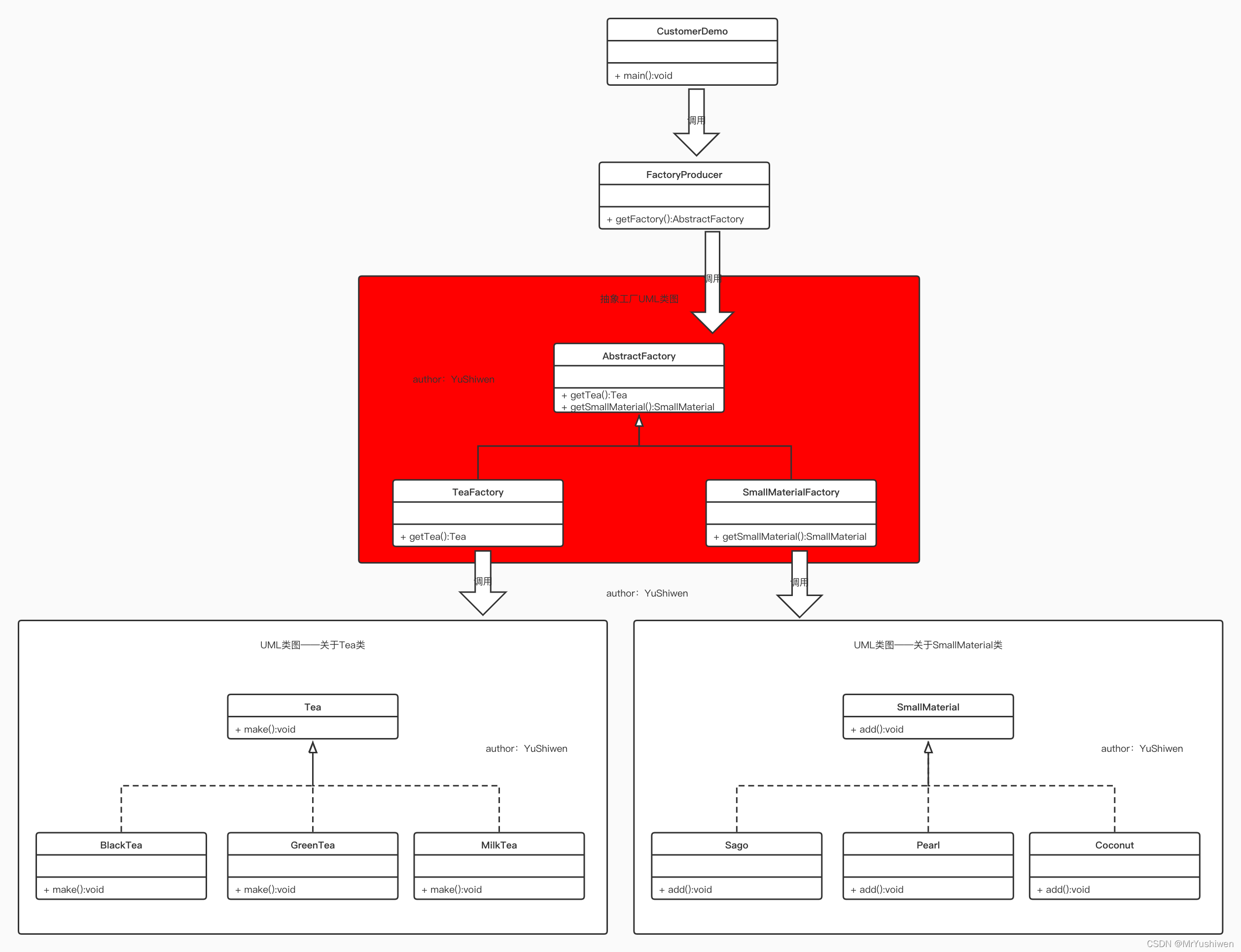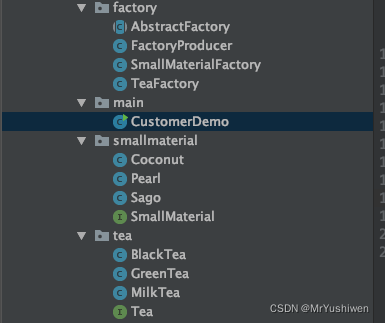Abstract Factory抽象工厂模式(Java代码实现)——创建型模式
在本人所编写的关于23种设计模式的文章中,前言基本上都是一样的,读者可以从章节2开始阅读,本篇是关于创建型模式中抽象工厂模式(Abstract Factory Pattern)的详解。
1.前言
根据Design Patterns - Elements of Reusable Object-Oriented Software(中文译名:设计模式 - 可复用面向对象软件的基础) 一书,四位作者把设计模式分为三大类,分别如下:
1.创建型模式
这些设计模式提供了一种在创建对象的同时隐藏创建逻辑的方式,而不是使用 new 运算符直接实例化对象。这使得程序在判断针对某个给定实例需要创建哪些对象时更加灵活。
- 单例模式(Singleton Pattern)
抽象工厂模式(Abstract Factory Pattern)- 工厂方法模式(Factory Method Pattern)
- 建造者模式(Builder Pattern)
- 原型模式(Prototype Pattern)
2.结构型模式
这些设计模式关注类和对象的组合。继承的概念被用来组合接口和定义组合对象获得新功能的方式。
- 适配器模式(Adapter Pattern)
- 桥接模式(Bridge Pattern)
- 组合模式(Composite Pattern)
- 装饰器模式(Decorator Pattern)
- 外观模式(Facade Pattern)
- 享元模式(Flyweight Pattern)
- 代理模式(Proxy Pattern)
3.行为型模式
这些设计模式特别关注对象之间的通信。
- 责任链模式(Chain of Responsibility Pattern)
- 命令模式(Command Pattern)
- 解释器模式(Interpreter Pattern)
- 迭代器模式(Iterator Pattern)
- 中介者模式(Mediator Pattern)
- 备忘录模式(Memento Pattern)
- 观察者模式(Observer Pattern)
- 状态模式(State Pattern)
- 策略模式(Strategy Pattern)
- 模板模式(Template Pattern)
- 访问者模式(Visitor Pattern)
本篇是关于创建型模式中抽象工厂模式(Abstract Factory Pattern)的详解。
2.抽象工厂模式(Abstract Factory Pattern)
2.1意图
提供一个创建一系列相关或相互依赖对象的接口,而无需指定它们具体的类。
2.2UML类图
抽象工厂模式(Abstract Factory Pattern)是围绕一个超级工厂创建其他工厂。该超级工厂又称为其他工厂的工厂。
在抽象工厂模式中,接口是负责创建一个相关对象的工厂,不需要显式指定它们的类。每个生成的工厂都能按照工厂模式提供对象。
如下(还是以现在热门的奶茶为例):

2.3Java代码具体实现
2.3.1包结构如下

2.3.2factory包
public abstract class AbstractFactory {
public abstract Tea getTea(String tea);
public abstract SmallMaterial getSmallMaterial(String smallmaterial);
}
- 1
- 2
- 3
- 4
/**
* @Author: YuShiwen
* @Date: 2022/2/5 12:55 AM
* @Version: 1.0
*/
public class FactoryProducer {
public static AbstractFactory getFactory(String factory){
if ("smallMaterial".equalsIgnoreCase(factory)){
return new SmallMaterialFactory();
}else if ("Tea".equalsIgnoreCase(factory)){
return new TeaFactory();
}else {
throw new RuntimeException("暂不支持改名称的工厂!");
}
}
}
- 1
- 2
- 3
- 4
- 5
- 6
- 7
- 8
- 9
- 10
- 11
- 12
- 13
- 14
- 15
- 16
/**
* @Author: YuShiwen
* @Date: 2022/2/5 12:48 AM
* @Version: 1.0
*/
public class SmallMaterialFactory extends AbstractFactory {
@Override
public Tea getTea(String tea) {
return null;
}
@Override
public SmallMaterial getSmallMaterial(String smallmaterial) {
if ("coconut".equalsIgnoreCase(smallmaterial)) {
return new Coconut();
} else if ("pearl".equalsIgnoreCase(smallmaterial)) {
return new Pearl();
} else if ("sago".equalsIgnoreCase(smallmaterial)) {
return new Sago();
} else {
throw new RuntimeException("其他茶品暂不支持!");
}
}
}
- 1
- 2
- 3
- 4
- 5
- 6
- 7
- 8
- 9
- 10
- 11
- 12
- 13
- 14
- 15
- 16
- 17
- 18
- 19
- 20
- 21
- 22
- 23
- 24
/**
* @Author: YuShiwen
* @Date: 2022/2/3 10:43 PM
* @Version: 1.0
*/
public class TeaFactory extends AbstractFactory{
@Override
public Tea getTea(String tea) {
if ("blackTea".equalsIgnoreCase(tea)) {
return new BlackTea();
} else if ("greenTea".equalsIgnoreCase(tea)) {
return new GreenTea();
} else if ("milkTea".equalsIgnoreCase(tea)) {
return new MilkTea();
} else {
throw new RuntimeException("其他茶品暂不支持!");
}
}
@Override
public SmallMaterial getSmallMaterial(String smallmaterial) {
return null;
}
}
- 1
- 2
- 3
- 4
- 5
- 6
- 7
- 8
- 9
- 10
- 11
- 12
- 13
- 14
- 15
- 16
- 17
- 18
- 19
- 20
- 21
- 22
- 23
- 24
2.3.3smallmaterial包
public interface SmallMaterial {
void add();
}
- 1
- 2
- 3
public class Sago implements SmallMaterial {
@Override
public void add() {
System.out.println("加入小料西米!");
}
}
- 1
- 2
- 3
- 4
- 5
- 6
public class Pearl implements SmallMaterial {
@Override
public void add() {
System.out.println("加入小料珍珠!");
}
}
- 1
- 2
- 3
- 4
- 5
- 6
public class Coconut implements SmallMaterial {
@Override
public void add() {
System.out.println("加入小料椰果!");
}
}
- 1
- 2
- 3
- 4
- 5
- 6
2.3.4tea包
public interface Tea {
void make();
}
- 1
- 2
- 3
public class MilkTea implements Tea {
@Override
public void make() {
System.out.println("make the milk tea!");
}
}
- 1
- 2
- 3
- 4
- 5
- 6
public class GreenTea implements Tea {
@Override
public void make() {
System.out.println("make the green tea!");
}
}
- 1
- 2
- 3
- 4
- 5
- 6
public class BlackTea implements Tea {
@Override
public void make() {
System.out.println("make the black tea!");
}
}
- 1
- 2
- 3
- 4
- 5
- 6
- 7
- 8
2.3.5main包
/**
* @Author: YuShiwen
* @Date: 2022/2/3 10:58 PM
* @Version: 1.0
*/
public class CustomerDemo {
public static void main(String[] args) {
FactoryProducer.getFactory("Tea").getTea("milkTea").make();
AbstractFactory smallMaterial = FactoryProducer.getFactory("smallMaterial");
smallMaterial.getSmallMaterial("sago").add();
smallMaterial.getSmallMaterial("Pearl").add();
smallMaterial.getSmallMaterial("Coconut").add();
}
}
- 1
- 2
- 3
- 4
- 5
- 6
- 7
- 8
- 9
- 10
- 11
- 12
- 13
- 14
2.3.6 运行结果

2.4优缺点
优点:
当一个产品族中的多个对象被设计成一起工作时,它能保证客户端始终只使用同一个产品族中的对象。
缺点:
产品族扩展非常困难,要增加一个系列的某一产品,既要在抽象的 Creator 里加代码,又要在具体的里面加代码。
建议:
抽象工厂模式是为了让创建工厂和一组产品与使用相分离,并可以随时切换到另一个工厂以及另一组产品;
抽象工厂模式实现的关键点是定义工厂接口和产品接口,但如何实现工厂与产品本身需要留给具体的子类实现,使用者只和抽象工厂与抽象产品打交道。
文章来源: blog.csdn.net,作者:Mr.Yushiwen,版权归原作者所有,如需转载,请联系作者。
原文链接:blog.csdn.net/MrYushiwen/article/details/122771734
- 点赞
- 收藏
- 关注作者


评论(0)